The Right Way to Waterproof Nice Boots
If you own a quality pair of shoes and you know what you’re doing, then you make sure you condition the leather every few months. Leather, after all, is skin. Keeping it moist is a critical component of ensuring your boots last a long time, develop a patina, and maintain their lustre and depth of color.
Waterproofing is a trickier beast. There’s a general consensus that just using a conditioner like Venetian Shoe Cream will help to improve a boot’s water resistance. But if you want to take things further, people start to disagree.
Silicone-Based Waterproofing Sprays
Waterproofing sprays are often a go-to, but that may have some consequences according to Philip Collias, the President of Zoes Manufacturing Co. (That’s the people who make Venetian Shoe Cream, probably the most beloved boot care product on Earth, along with a huge variety of other balms, oils, and care products.)
“What will hurt the leather is silicones and waterproofers,” he says, noting that waterproofing sprays are typically silicone-based. “That adds a coating and it’s very difficult to get off once it’s on because it penetrates into the pores. It does waterproof, but I would recommend not using it unless it’s an absolute last resort.”
You want your leather to be able to breathe, but silicone coats it in an almost impermeable layer that darkens the leather and requires a solvent to get off. It’s not a big deal for cheap shoes you’ll throw out in a week or two, but if you’re spending hundreds of dollars on boots then you may want to think of a more natural approach.
How to Waterproof Nice Boots
To make boots as water resistant as possible you want to start thinking about waxes, but that doesn’t mean you should just put wax straight onto your boot. The idea is to build layers of products.
1) Leather Cleaner
First, you want to clean the shoe to make sure you’re not trapping dirt and impurities under the layers you’re about to apply. Most boots will do just fine with a gentle, natural cleaner like Cobbler’s Choice. If the stains aren’t coming out, consider working with some Saddle Soap — but with caution. It’s very powerful and can strip out dye if you’re not careful — here’s our guide to using Saddle Soap.
An inexpensive cleaner made with all natural ingredients, it's easy to apply and contains tea tree oil for some anti-microbial properties.
2) Paste
Then you put a thin layer of paste on the leather, and you can add it to the welting as well.
“Dyanshine is a stain polish that also conditions, but our mink oil paste is also a good bet, particularly for the wintertime,” says Collias. “It can be used on its own or in conjunction with other creams for heavier waterproofing. It penetrates deeply but it allows the leather to breathe and conditions it further.”
3) Cream
Let everything dry out in a well-ventilated area, then take a cotton cloth and use it to apply a layer of cream.
Venetian shoe cream is the gold standard. While the precise contents are proprietary (believe me, I wanted answers) Collias says that the product contains six or seven different waxes (among other ingredients) and there are no thickeners or silicone or anything artificial. Basically, the product is a combination of many kinds of waxes each with their own purpose: one moisturizes, one gives more shine, one preserves, and so on.
That final layer of cream will add a soft glow but keep things pretty matte. If you like things shinier you might consider something like Saphir’s Renovateur. Or…
4) Polish
When we said layers, we meant it! Finishing the cream with some polish, of course, helps to make the boots shinier but it’s important to note that polishes also have a protective effect and will build up in the leather if you use the polish on a regular basis, like every two to three weeks.
There you have it! Collias uses the same four-layered process on all smooth leathers whether they’re vegetable tanned, chrome tanned, or oil tanned. Sure, you could spray on silicone like a mook, but if you really care about your boots and want to amp up the moisture and water resistance while preserving and maintaining their appearance, this is your blueprint.


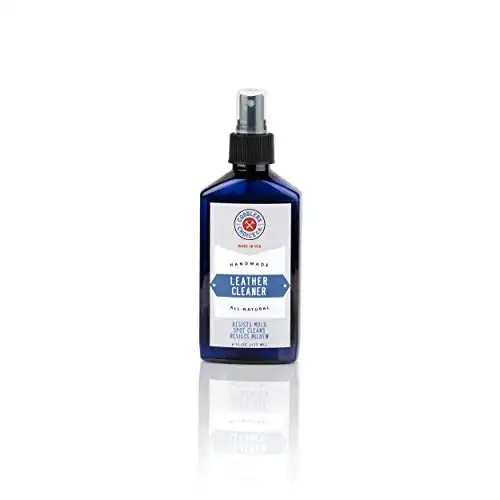


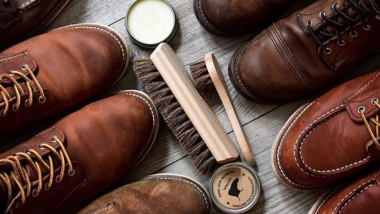
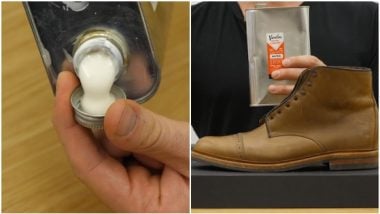
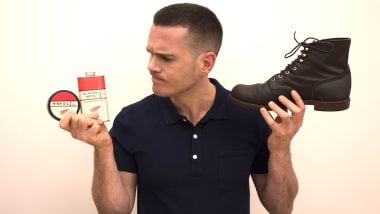


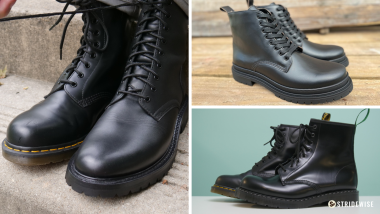


Hey so I got a new pair of TBC brandy colored Captains. So I was super stocked and wanted to keep them conditioned and waterproof. So before wearing them I put some Venetian cream on em and they looked great. Then I thought let’s make em waterproof and put on some pro Tex water and stain resistant spray and after I sprayed it I let it set and noticed blotches of discoloring in the leather. Needless to say I woke up this morning and took it straight to the cobbler in hoping he can remedy the situation. Can u help me on what I need to do in future shoe care I’m new to the whole leather boot thing.
Sorry to hear that Daniel! I’d just go with the steps in this review? I think water and stain resistant spray isn’t a great idea for boots you want to last a long time, but saddle soap might be able to get it out, MAYBE. I’d chat with your cobbler!
Is this routine recommended for dress shoes as well? And if so how often would you employ this routine for normal wear and tear?
Yes this should work for dress shoes, I don’t think you’d need to do it more than once a year or so depending on how wet they get and how often.
Should a pair of Captains in Old English be waterproofed prior to use in downtown Toronto with potentially wet/rainy/snowy(shoveled) conditions? Or, are they good straight out of the box? Or maybe conditioned prior to use?
I am also confused about the difference between the Cobbler’s waterproofing spray vs the water repellent .. any experience or thoughts on those?
Thank you!
Hmmm. They have a 360 degree Goodyear welt so I think it’d be fine. The water repellant spray is more for heavy duty weatherproofing. I think you could use that if you wanted, I’m not sure of the effect it’ll have on the aesthetic, though.
In the world of outdoor boots, people have been using wax-based waterproofing pastes for over a hundred years. Usually it’s some combination of beeswax and mineral oil, maybe with some conditioners thrown in. Bee Seal and Sno Seal are old-school brands that are still around. How these differ from wax-based conditioners like Venetian is impossible to know, since the self-important goofs at Venetian won’t share their ingredients.
The idea that silicone will prevent leather from breathing is nonsense. I’d challenge them to cite a single study that demonstrates this. Waxes and oils will clog pores; silicone coats the leather fibers with a hydrophobic finish. The reason to avoid silicone is that it never comes off completely, and can interfere with a cobbler’s ability to resole shoes that require gluing. But for the same reasons, you should avoid waxes on these shoes. And anyway, you guys are almost always talking about welted boots that don’t require gluing.
Here’s a mind-bender: you really don’t have to worry about the breathability of leather boots, because for all practical purposes, they don’t breathe at all. This has been confirmed by scientific tests done on climbing boots. The leather is just too thick. It turns out that these boots keep your feet dry purely through absorption. And your socks do more absorbing than the leather … so pay attention to them.
For boots with resoleable glued-on soles (most modern climbing boots) all the manufacturers recommend Nikwax products. They coat the fibers the way silicone does, but they don’t have the problems of silicone. They don’t waterproof as well as waxes, but are pretty good. For other boots, I’ve had great luck with Obenauf’s. This seems better than the Sno Seal and Bee Seal of yore, because it has effective conditioning ingredients.
“self important goofs,” I love it. Thanks for your thoughtful comment, Paul! I’d love to set up a debate between people on either side of this conditioning discussion just to hear all the points. People on both sides are so convinced they’re right…
As an attorney, I can respect the self-important goofs at Zoes for not disclosing ingredients. Everyone wants to steal everything these days. The people who are generous with disclosure tend to get screwed by the takers. It’s the way of the world.
Haha fair enough, Jerry! If my whole business was my formula I’d probably be the same way
Call me crazy but I don’t use any pairs for real rainy days or snow. I keep a pair of CAT second shift in brown nubuck and experimented with cooking oil. Olive or sunflower. I saturated the leather and it works fantastic. For the record I was told by mountain people in the alps that back in the days before all the new tech for creams and materials like gore tex and whatnot people were using pig fat to waterproof their snow shoes. Natural and efficient. My pair is a few years old now and didn’t suffer from excessive moisture or anything. It looks pretty good and it’s fine to walk in the snow or during the monsoon. Obviously this works only on nubuck.
Pig fat, interesting!
Hi there. I’m looking for a process of breaking in a new pair of Corcoran boots. People say this, people say that.. I’m going to strip the factory finish to allow absorption of Mink Oil which I will be applying around 4~5 coats of and using a hairdryer to warm the leather gently before each coat that will be applied internally and externally, allowed to dry and then placed tightly every day for as long as possible…
Thoughts?
Hey Michael, if they’re uncomfortable then these tips might help! https://stridewise.com/how-to-break-in-boots/
Thanks for the info in thsi article. I’m always mucking around in water so this is helpful as I try to keep my feet dry!
Hey good luck bro!
For chrome tanned boots and leather, I’ve NEVER been disappointed in Sno-Seal. It has proven itself to me and others I know (more avid hunters and outdoors people than I can count) over the course of 50 years.
I find it incredible you did not even mention it in your article.
Incredible.
Just saying.
Otherwise, I very much enjoyed stopping by and reading the article.
Thanks.
Honestly Brian I’ve just heard a lot about Sno Seal darkening leather and maybe interfering with a nice patina — you haven’t?
What about Saphir Super Invulner Spray? They describe it as “a highly-concentrated water repellent containing fluoridated resin. Formulated without silicone, it contains a non-aggressive and non-greasy solvent to avoid damaging or discolouring fragile surfaces. It is suitable for use on the most expensive and delicate materials such as nappa and silk.”
Yes, Invulner is a solid product as well.